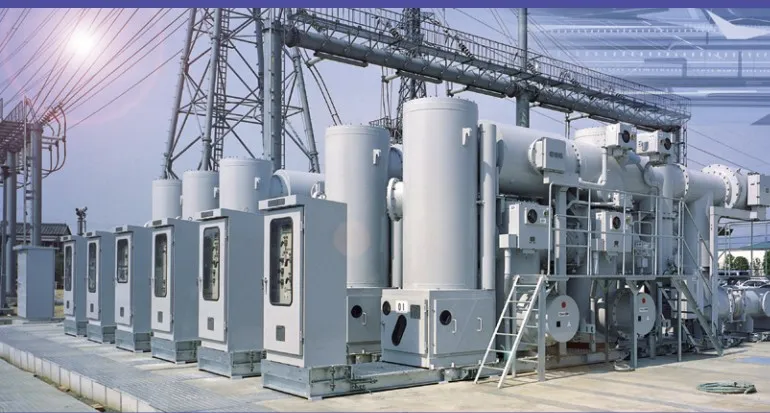With urban populations on the rise and space becoming a precious commodity, Gas Insulated Switchgear (GIS) has emerged as the ultimate solution due to its compact design and superior functionality.
In this article, we dive deep into the realm of GIS, unveiling its definition, operational mechanics, and exploring the vast array of applications and advantages it offers.

Understanding Gas Insulated Switchgear (GIS)
GIS represents a sophisticated electrical apparatus housed within a sturdy metallic framework. It accommodates diverse components such as circuit breakers, bus bars, transformers, earth switches, and surge arrestors. These elements reside within shielded compartments flooded with sulfur hexafluoride gas (SF6) and segregated by barrier devices.
The primary mission of a GIS substation revolves around switching, segregating, transforming, measuring, and disseminating electrical energy within power systems. The standout characteristic lies in its reliance on SF6—an inert gas boasting exceptional insulation properties, chemical stability, and resistance to heat.
In stark contrast, conventional air-insulated switchgear (AIS) demands considerably more space for effective insulation when juxtaposed with the efficiency of GIS. This inherent efficiency renders GIS a dependable, space-conserving, and low-maintenance alternative.
GIS has carved a successful trajectory since the late 1960s and early 1970s.
Advantages of Gas Insulated Switchgear
- Ideally suited for locations with limited space or elevated pollution levels
- Compact design that seamlessly assimilates into environments without compromising aesthetics
- High reliability and resilience against environmental challenges, including earthquakes
- Elimination of electrical failure risks due to wildlife interventions
- Configurable for diverse bus bar arrangements
- Elimination of oil leakage or explosion hazards
- Minimal maintenance requisites
- Streamlined installation procedures
- Quiet operational demeanor
- Reduced operational costs
Gas Insulated Switchgear, with its pioneering design and multifarious benefits, continues to shape the future of electrical distribution. Its compact proportions and exceptional performance have made it an indispensable component in modern power systems, ensuring the dependable and efficient distribution of energy.

Gas Insulated Switchgear vs. Air Insulated Switchgear
Here’s a comparative analysis between GIS and AIS:
Air Insulated Switchgear (AIS)
- Design standards: IEC (e.g., IEC 62271-1, IEC 62271-100, IEC 62271-200)
- Bus bar insulation: Air medium
- Switching: Oil, air, vacuum, or SF6
- Execution type (switching): Fixed or design-based
- Size: Larger (tens of square meters)
- Sensitivity to external elements: Moderate
- Maintenance requirements: Moderate
- Cable necessities: Variable
- Gas pressure monitoring: Exclusive to SF6-equipped switching devices
Gas Insulated Switchgear (GIS)
- Design standards: IEC (e.g., IEC 62271-1, IEC 62271-100, IEC 62271-200)
- Bus bar insulation: SF6 medium
- Switching: Vacuum or SF6
- Execution type (switching): Fixed
- Size: 10-30% smaller than AIS
- Sensitivity to external elements: Excellent
- Maintenance requirements: Minimal
- Cable necessities: Specific
- Gas pressure monitoring: Applicable to both switching devices and bus bars

Applications of Gas Insulated Switchgear
GIS substations excel in compact, armored designs, rendering them the preferred choice for installations in space-restricted areas or locations exposed to elevated pollution levels. These may include:
- Industrial townships
- Hydro stations
- Underground substations
- High-pollution areas
- Urban expansions
- Offshore platforms
- Rooftop installations
- Railways
- Power transmission
- Integration of renewable energy sources
- Large towns with limited space
- Valleys
- Mountainous regions
- Industrial complexes
- High-voltage transmission systems
The Inner Workings of GIS
GIS safeguards electrical power supply and distribution by selectively interrupting current flow within an electrical circuit when necessary. Under normal conditions, breaker contacts remain sealed. However, in the event of an electrical system malfunction, these contacts part ways, giving rise to an electrical arc between them.
The mobility of these contacts is synchronized with a valve that permits high-pressure SF6 to enter the chamber where the arc ignites. SF6’s unique attributes empower it to absorb free electrons along the arc’s trajectory, forming ions devoid of electrical charge due to their increased mass. Consequently, the gas’s dielectric strength significantly escalates, extinguishing the arc.
Once the arc is extinguished, SF6 pressure dwindles. It is then stored in low-pressure and high-pressure tanks for future utilization. SF6’s rapid recombination capability further amplifies safety.
GIS operates effectively within minimal insulation space, making it an ideal choice for medium and high-voltage power systems.
This comprehensive overview underscores the pivotal role of Gas Insulated Switchgear in revolutionizing electrical distribution, offering a sustainable and reliable solution for modern power networks.

